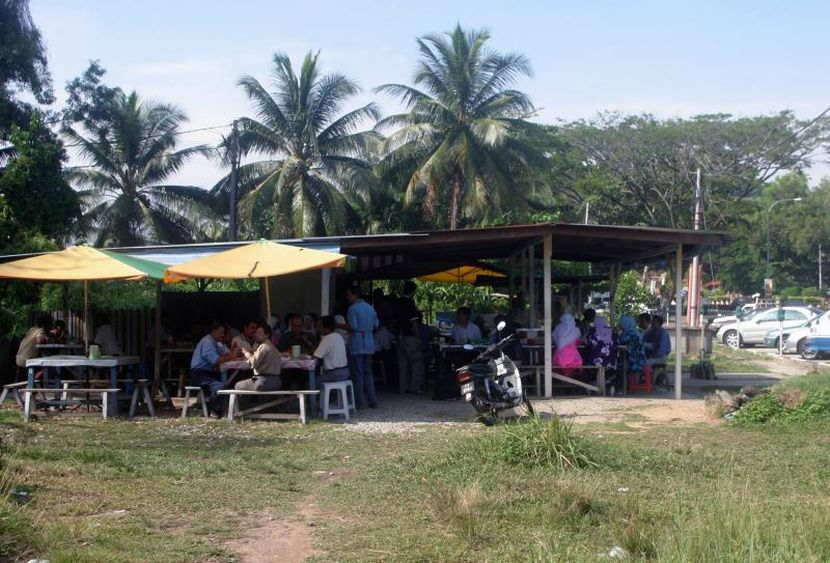Besides flood ponds becoming houses, here are 3 other shady cases found in KL’s land audit.

- 755Shares
- Facebook704
- Twitter7
- LinkedIn3
- Email3
- WhatsApp38
Tea alert! Tea alert! Get your teacups ready, because we about to have a tea party!

Gossip time! Gif from Gifer.
Remember the floods in KL from a few weeks ago? Well, last week, MP Hannah Yeoh made headlines when she told MACC to check out some shady developments in KL that might have caused those. Citing the Auditor-General’s Report 2019, she mentioned that six flood retention ponds in KL had been given away to developers to make stuff like affordable houses and service apartments, among other things.
“The devastation caused by the floods last week must be a wake-up call for MACC and DBKL to spring into action. It was also clearly revealed that in the same period from 2015 to 2020, Kuala Lumpur experienced flash floods 48 times,” – Hannah Yeoh, as quoted by Malaysiakini.
Naturally, we couldn’t believe that such things happened, so we fact checked by reading the audit report ourselves. And we found out more tea than we set out to brew. The audit was done to compare a plan drawn up by KL City Hall (DBKL) called the Pelan Bandar Raya Kuala Lumpur 2020 (PBRKL 2020) against what really happened in the city, and among other things, they discovered 943 developments approved by the city that didn’t align with said PBRKL 2020.
Of the 943, they looked at four of the plans more closely, and spoiler alert: all of them had some degree of fishiness. Because the report is kinda long and technical, we’ll simplify the cases for you today, starting with…
Case #1: Flood retention ponds developed into apartments, houses, and hawker spots
[Disclaimer: we didn’t use the proper technical terms to make this more understandable. Please forgive our street-ness.]
This was the case that Hannah Yeoh was talking about. As of Dec 2020, KL had 15 flood reservoir pools, but audit found that 6 of them had been approved for development.

Screengrabbed from Auditor-General’s Report.
Audit focused on the Taman Wahyu pond, which had been reserved as a flood retention pond since 1998, but had yet to be gazetted. In 2015, a company (971210-P) applied to get this land to be developed into a mixed development project. Later that year, it was decided that the pond’s reservation would be cancelled to allow the land to be transferred to the company, with some conditions.
KL’s Department of Irrigation and Drainage (DID) said that the company can put a mixed development there, as long as they don’t affect its flood mitigation function: no reducing the water capacity, and no touching flood mitigation structures without permission. The company received a green light in 2017, despite protests from Taman Wahyu’s Residents’ Association continuing well into 2018.

Probs the authorities upon receiving the protests. Gif from Tenor.
Despite the caveat, it seemed that problems arose anyway. According to a response by DID in Jan 2021, they seem to acknowledge that the development did affect Taman Wahyu’s pond somewhat.
“The change in use of the flood reservoir pond (in Taman Wahyu) for development had not only affected its capacity, but also crippled the whole Kuala Lumpur Flood Mitigation system and exposed KL to the risk of more frequent floods.” – excerpt from DID’s response, translated from the 2019 audit report.
Case #2: High density apartments approved after talk with Minister
Also in 2015, a lot in Taman Desa was given to company 978433-P, to be developed into apartments. This lot of land had been initially zoned for infrastructure and utility, as Tenaga Nasional Berhad (TNB) had their underground electrical lines there.
Despite TNB and DBKL’s City Planning Department (JPRB) pointing out that there shouldn’t be plans to develop the land, the Land Administrator then had said that the application should be considered for approval to ‘prevent the continual losses to the Government due to trespassing and non-optimal land use’. He endorsed the approval, but that’s not the shadiest thing about this case.

This some masala tea right here. Gif from Giphy.
The company’s development plan was later put on hold as it involved exceeding the allowed density of 500 persons per acre (ppa). However, it was revealed that the company had appealed to the Federal Territories Minister then to allow a density of 650 ppa, and the Minister had then ordered the Mayor to consider the application. The Mayor then agreed to raise the density to 580 ppa, subject to the views and protests of the area’s residents.
And hoo boy, did they protest. The audit found records of protests from at least 4 residents’ associations, the PIBG from at least two schools, Seputeh MP’s office, and several others. Among the issues raised include the high density, the safety of children in nearby schools, and inadequate water supply, a concern that was supported by Air Selangor (then SYABAS) themselves.
Despite the significant protests, the approval was given to the company anyway in 2017.
Case #3: Authorities seem to have went out of their way for a developer
There is a land lot in Bangsar Baru that was given to the authorities by a company (10531-H) as a green space. Sometime in 2001, another company (200714-A) tried to get this land, but the application was rejected then on the basis that the lot needs to stay as a green space. However, DBKL agreed to issue them a Temporary Occupation License then, which allowed them to construct only temporary buildings there.

We dunno what temporary buildings mean, but we assume it’s something liddis. Img from mStar.
Company 200714-A had then applied to get a lease on the land instead, and it was allowed. Fast forward to 2005, and the company‘s plan to build a 12-storey block of offices/service apartments was rejected because it was deemed to be too intensive for the space. The company amended their plans, and later that year it was agreed that the new plans can be considered subject to protests from the people.
Among the people who protested were the Bangsar Baru Residents’ Association, a nearby mosque, and company 10531-H, whom you might recall as the original owner of the lot. The issues raised include potential traffic congestion in the area and parking woes, but unlike in the previous case, these protests were heard: the Mayor then proposed six alternative locations to the company. However, all of them were rejected.

Gif purely for decoration, from Pinterest.
Somehow or other, five years later the FT Minister agreed with the company’s plan to build a block of commercial building on the original site, while the DBKL’s JPRB endorsed the plan’s approval on the basis that it fulfills requirements. So in 2017 company 200714-A‘s plan was approved, but the appeals by the resident association continued until 2018.
According to a response by DBKL in 2021, the decision was made as the area was within the International Zone, and the development of a career center including office activities was ‘encouraged to serve both local and international residents’.
Case #4: A land lot went from gas station to service apartment to being sold off at 25 times the price
In 2013, a 0.65 ha lot in Taman Tiara Titiwangsa, originally zoned as a public space, had been given to company 1009398-A with the condition that it’s for a gas station. Fast forward to 2017, things suddenly escalated when a plan was approved for the building of a 32-storey service apartment there instead.

Time travel at the spot be like… Gif from Tenor.
Audit found that the company’s apartment plan was initially rejected because it didn’t fit with the surrounding bungalows in the area, but after a series of appeal and considerations, DBKL agreed to consider it provided that the plot ratio – the ratio of the floor plan of the building to the overall lot area – does not exceed 1:5.
An approval with this condition was given in 2017, and the zone use was changed to mixed development. However, that’s not the end of the drama: in 2019, it was found that the developer had sold off the lot to a third party for a huge profit: RM45 million, versus the original RM1.67 million paid.
There are more things in the report that we couldn’t include to keep this article short-ish, like the sales of land by the Mayor and other stuff. But if we simplified the cases well enough, by now you might be saying to yourself…
What the heck?! How is nothing done about these?
We’re not sure whether the Audit department picked these four lots to audit randomly. But if they did and all four have a fishy smell to it, it’s worrying to think about how the other 939 approvals – the ones that didn’t align with the PBRKL 2020 – might smell like. While technically the Mayor can legally approve what he deems as suitable to the city regardless of the PBRKL 2020 [Section 22(1) and (4) of the Federal Territories (Planning) Act 1982], it’s hard to read the audit report without feeling suspicious of what really happened in KL’s planning process.
As the recent disaster had proven, the consequence of bad planning can be more than just bad traffic and congestion: in the case of vital things like flood retention ponds, people’s lives may be affected as well. After the issue was highlighted, several other politicians had since insisted that the MACC look into the allegedly shady status changes of KL’s retention ponds. MACC had commenced their investigation, but whether or not any wrongdoings will be found, though, is a different story. Let’s hope they won’t get too distracted in the meantime.
- 755Shares
- Facebook704
- Twitter7
- LinkedIn3
- Email3
- WhatsApp38
